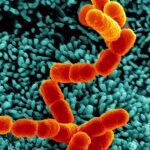Link to Pubmed [PMID] – 11705944
Infect. Immun. 2001 Dec;69(12):7642-51
The pathogenicity and prevalence of Mycoplasma penetrans, a Mycoplasma species recently isolated from humans, are still debated. A major P35 antigen, which is used as target epitope in serological assays, was shown to be a phase-variable lipid-associated membrane protein (LAMP). In this study, we performed a comparative analysis of the LAMP patterns from five M. penetrans clinical isolates and from the type strain. Sodium dodecyl sulfate-polyacrylamide gel electrophoresis profiles and immunoblots with sera serially collected from an M. penetrans-infected patient indicated that these strains expressed different LAMP repertoires. Furthermore, the intraclonal variation in the expression of LAMPs (P34A, P34B, P35, and P38) was monitored by immunoblot analysis with three specific monoclonal antibodies (MAbs) developed in this study and MAb 7 to P35. The phase variation of these LAMPs occurs in an independent manner, with frequencies of variation ranging from 10(-2) to 10(-4) per cell per generation. Consistent with their amphipathic nature, the P34B and P38 antigens were found exposed at the cell surface. The DNA sequence encoding the P38 antigen was defined and found to be related to those of the P35 gene and other putative LAMP-encoding genes, suggesting that these variable antigens are encoded by a family of related genes. Finally, the serum samples from an M. penetrans-infected patient contained antibodies that reacted with a P36 antigen expressed in different M. penetrans strains but not in the isolate recovered from this patient. This result suggested that in vivo phase variation of P36 occurred, which would support a role for these LAMP variations in avoiding the host’s immune vigilance.

